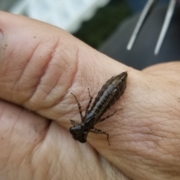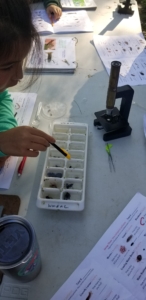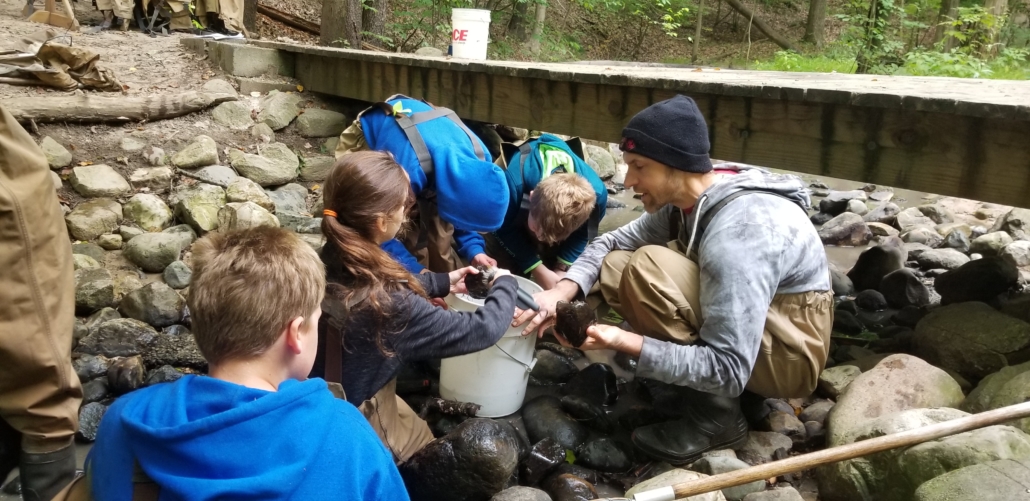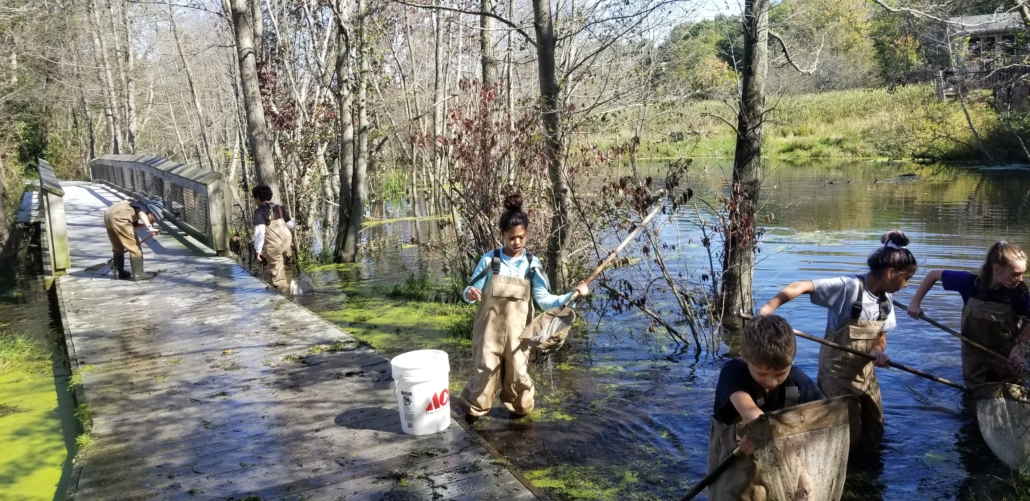[av_textblock size=” font_color=” color=” av-medium-font-size=” av-small-font-size=” av-mini-font-size=” av_uid=’av-k4oigpgt’ custom_class=” admin_preview_bg=”]
Can this go on: Reflections on the Environmental Education internship at WMEAC
[/av_textblock]
[av_textblock size=” font_color=” color=” av-medium-font-size=” av-small-font-size=” av-mini-font-size=” av_uid=’av-k4oienfk’ custom_class=” admin_preview_bg=”]

[/av_textblock]
[av_textblock size=” font_color=” color=” av-medium-font-size=” av-small-font-size=” av-mini-font-size=” av_uid=’av-k4ohxw84′ custom_class=” admin_preview_bg=”]
by Matt Bain
Each Spring and Fall, WMEAC offers a number of different internships, the Environmental Education Internship being one of them. This past Fall, Paige Lackey and I were each fortunate enough to receive an EE Internship. Our main role, as Environmental Education interns, has been to work within the Teach for the Watershed (T4W) program. If you’re not familiar with the program, T4W is designed for middle school classrooms to learn about water quality and comprises a lecture followed up with a field trip, 1. It is headed by the quite capable Kyle Hart and classroom veteran Thea Van Goor, and supplemented by WMEAC interns and volunteers. The fieldwork portion of the program allows students to experience the basics of biomonitoring using aquatic macroinvertebrates at a stream in their local watershed, 2.
Typically, the fieldwork portion is favored by the students (but who doesn’t prefer a field day over a lecture?) and lack of enthusiasm is the rarest of problems. The title of this post, “Can this go on,” is actually a quote from one of the many students I had the privilege of mentoring during my time as an intern. It can have numerous meanings, given the context, or, sometimes, within the same context, simply depending on which words are emphasized, 3. It’s become the compressed summary of my experiences as a Teach for the Watershed mentor.
RBP till I RIP

Coming into the T4W program with a Bachelors of Science in Biology, and having spent the greater part of the preceding summer doing biomonitoring in the form of Rapid Bioassessment Protocol (essentially the procedure that the Michigan Department of Environmental Quality – aka EGLE – uses to assess stream health), I felt more than ready to take some 4th-6th graders out into a stream with waders and splash around a bit. Scare up some water “bugs”. Pass on some macroinvert know-how… How hard could it be? A cinch, right. Mmmmm…I know the Latin names of most aquatic macroinvertebrates commonly found in our southwestern Michigan watershed…but not how to say not quite.
Adventure 1. Blandford Middle School
This was my introduction to the first portion of T4W: a classroom lecture about the threats of pollution to our watersheds. I met Kyle early one morning in September to be mentored, myself, by watching and taking notes as he conducted the lesson. Despite having been up in front of numerous classrooms and working as a Teaching Assistant at Grand Valley for my advisor, I was still fairly nervous. I’d studied the material and practiced but still felt unprepared without direct training (Kyle didn’t help my nervousness, by the way, when he said “Don’t worry, I won’t make you do the first one…” which seemed to insinuate I’d be doing the second lecture on the first day). I won’t go into detail here about the classroom portion, as I’m intending to focus on the fieldwork, except to say that the Blandford kids were super polite and very receptive and it all boded well for taking them out into the “field.”

The Blandford kids definitely had a leg up as the field in question is the backyard of the school – a portion of the fields, forests, wetlands, and prairies that comprise Blandford Nature Center. So a week later we simply met at the school and walked down a morning-dark path into a nearby ravine. Our WMEAC team consisted of Kyle, Paige, Thea, Sara Vruggink, and Kyle’s mother, Kathleen, a retired teacher, who had eagerly volunteered. “I gotta get my kid fix,” she said, as we marched the wader rack down to the ravine. Everyone pitched in to haul shoulder-fulls of waders down and hang them by the heels. Thea had taken the initiative to hand paint the sizes, upside down (foresight!), on the tips of each boot. Kyle and Sara set up our ID station, which consists of easy-to-use, laminated, identification guides for commonly found aquatic macros, 4, large white tubs to hold organisms for observing, aquarium nets for fishing out the banana plant for aquarium and plastic spoons for capturing, ice cube trays for sorting, and simplified microscopes for the obvious.
After this, Kyle, Paige, and I put on waders and went into the creek – Brandywine Creek – contained in the ravine and sampled for about 40 minutes, 5. Well, after 40 minutes, I was disappointed by the lack of biodiversity we’d found, but, given our position, downstream of a heavily urbanized area with tons of impacts, I’m not sure what I expected. The immediate woodland surroundings make major pollutants seem counterintuitive. But there was plenty of litter caught on snags and the sickening bright, washed-out rainbows of petroleum. Looking into our buckets and the meager collection of water striders (highly tolerant of pollution), a few damselfly larvae (moderately tolerant), scuds (moderately tolerant), and isopods (highly tolerant), I thought, these kids are going to be really disappointed. This is a bummer. And I wished we could remove them to a pristine creek where we could scare up some water pennies, casebuilding caddisflies, even some crayfish. But therein lies the challenge in any task undertaken – making due with what you have, or making the best out of the situation at hand.
But this was all putting the cart before the horse or bucket before the sampling. First we had to get a set of approximately eight 6th graders into waders that fit, something I’d never done. I learned that 6th graders are not quite old enough to know their shoe size and that most of the size labels in sixth-grader shoes are worn away as if by acid. And I learned that you always go up a size when putting on waders. And I learned that I was really thankful that Thea, who also has 10 years of teaching K-12, was there to help fit the kids out. And that there’s always one kid who has suddenly and inexplicably forgotten how clothes work and needs to basically be put into waders.
Next, everyone selects a net and I explain to them a bit about safety: when you dip your net and bring it out of the water, you have to watch the net staff so that it doesn’t bonk someone close to you. The sudden visual of a screaming child with a bloody nose came into my head – then someone being poked in the eye… and I went to mental Defcon 3. After the waders and explanation, I realized half of these kids, at least, had never went wandering around through flowing water in a pair of galumphing waders.
Sudden visual number 2.: a child half-soaked and crying, covered in mud, while their waders fill up with cold water, or worse, falling and hitting their head. By this point, I was no longer worried about the lack of biodiversity we’d find, but simply returning from our sampling with no one injured, bleeding, crying, and/or soaked (I think the constant prayer in my head went something like, Please don’t let anyone fall or get hit in the face). I did my best to proceed slowly, but was told I had about fifteen minutes before they had to get out and de-wader.
I’m sorry to say that I don’t remember many specifics from that first group. I was entirely focused on the multitask of watching eight kids – a small group of which had already gone way too far ahead (“Guys! Don’t go any farther, please.”) – while sampling with them, holding the bucket, reminding them, after a few close calls, to watch their net-staffs; fielding questions about what to do with all this plastic; grabbing an arm, here, to catch someone as they fell and nearly went in; all while working the mantra, No falls, no bloody noses – no falls, no bloody noses.
All I know is that we got back safe, unhurt, mostly happy, with some fresh macros in our bucket. That was group 1. And as soon as they slid out of their waders and rushed off to the ID station, Thea and I were suiting up group 2.
It all has to move pretty quickly as there are four stations in total and we have a limited time for each group to do all four stations (~2 hours). By group 3, I had found my stride and was finally able to really take in and enjoy the experience. The kids were very focused on any litter they found in the creek and we began making a pile on the shoreline. They were also actively listening to some of the sample techniques I demonstrated and were finding a few macros I wouldn’t have thought existed in Brandywine.

Best part of the day? Thea brought our attention to a rocky habitat in the opposite direction of the one we’d been walking. She and some kids had found a few leeches there. So I took group three onto the rocks, in very shallow water – a riffle without the typical flow – and brought out a scrub brush to scrub the rocks into our nets. I remember sitting with students, in very peaceful waters, removing caddisfly larvae and flatworms from the rocks. Placing them in the buckets with our fingers. Discussing, in simple terms, their lives (their ecological role) in the stream.
A summing up
We had ten fieldwork sessions, in total, over a two month period. Spanning seven different watersheds. Ten separate and distinct adventures, each of which taught me something different as I, in turn, did my best to teach the numerous mentees (455 to be exact! Thank you, Kyle).. The educational process of T4W is an open loop among all participants – employees, mentors, interns, mentees, volunteers – where everyone is constantly learning and adapting to the present, constantly fluctuating situation. That was my experience, at least. It was often trying, mentally and physically (due to weather and wet, cold), leaving me, always, with a feeling of accomplishment at the end of each session. I also left each fieldwork day with an idea of what I could do better. That’s one of the most important aspects, for me, of any task – what could I do better next time? A huge motivating factor. Never to settle.
Equally important, though, is that we celebrate the work we do, and our attempts, failed or not. I sit writing this post with a head-full of moments, some wonderful, some scary, all vibrant and cherished in hindsight. But I’d like to leave you with one that I referenced earlier as it encapsulates the entire experience for me.
Can this go on?
We were conducting fieldwork with Ottawa School students at Hemlock Crossings (Pigeon Creek) in Holland. I was directing my 3rd group of 5th graders out of the cold-dark creek back toward the wader station when a straggler – Gabe or Gibson – asked if he could hold the small crayfish we’d netted. (This was a pleasant surprise as, earlier, he wouldn’t remove it from his net, even after much coaxing). “Can I carry it?” he asked. “Sure.” And once it was on his hand, “Can I keep it?” I wasn’t able or willing to say no, him being so plaintive. I considered letting him ferry it over to the macro ID station, when he said, watching it crawl along his hand, “Can this go on?” I took him to mean Can’t I just keep experiencing this? Although he might have meant the entire sampling activity – a feeling I’ve often had myself (when the temperatures aren’t below freezing…). The crayfish fell once and I convinced “Gabe” to put it in the bucket. “It’ll be waiting right here while you take your waders off,” I told him. Waders up, I entrusted the bucket to him and asked if he’d take it to the ID station with him. He happily obliged. I was sad to see them go.
Since then, “Can this go on?” has been my trope. A wistful mantra that easily replaced No falls, no bloody noses. And I consider it, now, as the season of my internship, with the waning year, comes to a close.
Banner Photo Credit: Kyle Hart – Students explore the waters of Pine Creek at Stu Visser Trails in Holland, MI. Aquatic organisms that are sensitive to pollution are collected in a bucket and used to estimate the water quality.
[/av_textblock]
[av_hr class=’default’ height=’50’ shadow=’no-shadow’ position=’center’ custom_border=’av-border-thin’ custom_width=’50px’ custom_border_color=” custom_margin_top=’30px’ custom_margin_bottom=’30px’ icon_select=’yes’ custom_icon_color=” icon=’ue808′ av-desktop-hide=” av-medium-hide=” av-small-hide=” av-mini-hide=” av_uid=’av-nx3vue’]
[av_textblock size=” font_color=” color=” av-medium-font-size=” av-small-font-size=” av-mini-font-size=” av_uid=’av-k4ohzfal’ custom_class=” admin_preview_bg=”]
1. The lecture portion involves a discussion of major pollutants impacting our watersheds, and the employment of a very cool, beloved, model watershed, the Enviroscape (SEE https://www.youtube.com/watch?v=s8vv_wHdUcQ) (“Pollutants” – in the form of table salt for Road Salt, chocolate sprinkles for Animal Waste, etc. – are added by the students and stormwater – via spray bottle – is simulated.). We also spend some time, after the Enviroscape demonstration, talking to students about ways they can mitigate their impact on the environment.
2. Macroinvertebrates are the choice subject for most aquatic biomonitoring programs because they are common in freshwater habitats, myriad of species, often sedentary, have multi-seasonal lifespans, and offer a wide range of tolerances across taxa.
3. Consider the Seinfeldian “Can this go on?” vs. “Can this go on,” as rhetorical and plaintive. “Can this go on?” a sort of prayer for endurance. Or, even, “Can this go on?” as a rhetorical question referencing our environment and the exponential impact we’re having on it each day.
4. Picture guides with key characteristics and fun facts on each organism.
5. We “pre-sample” so that the first rotation of students will have something to observe.
[/av_textblock]


